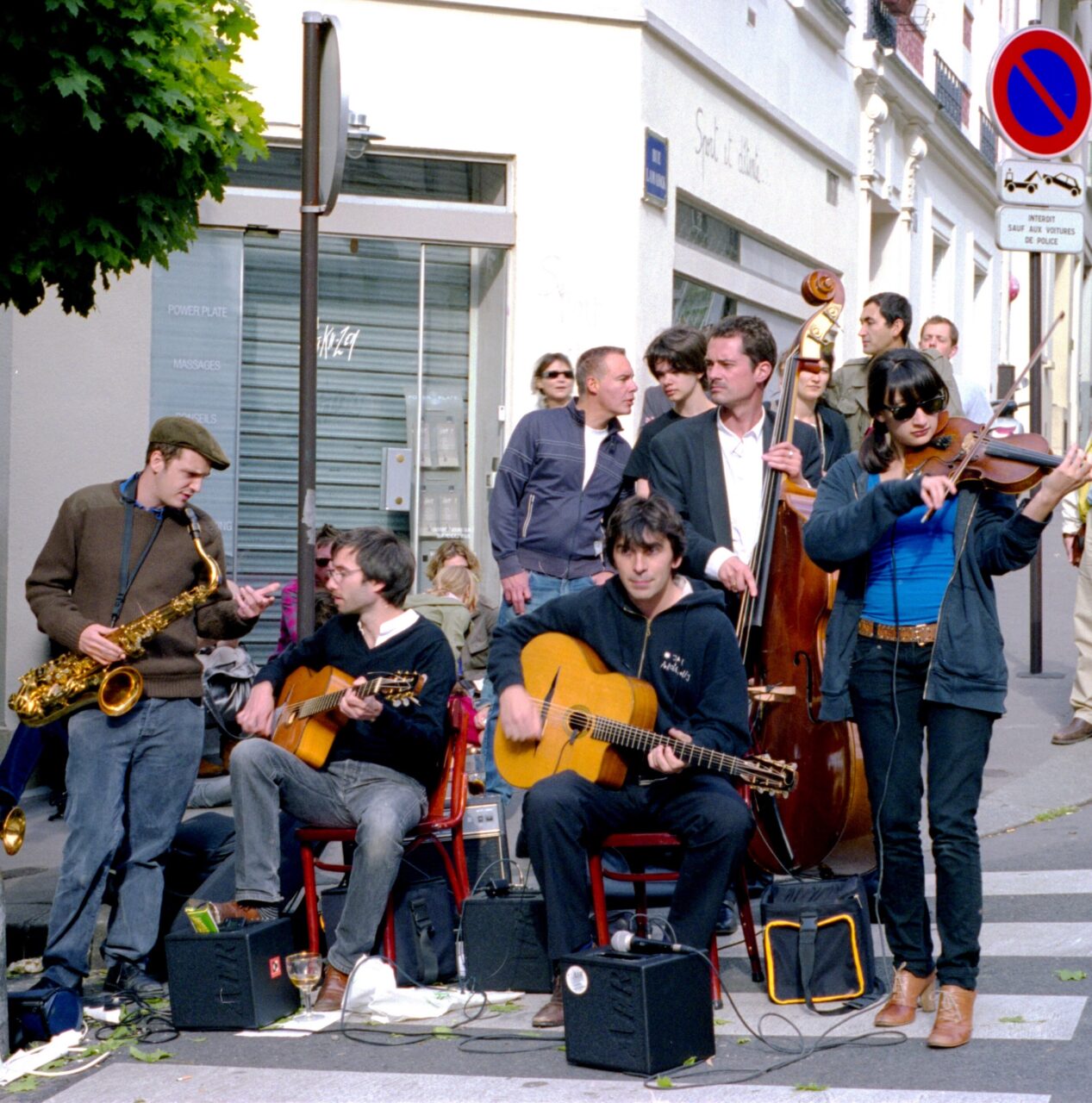If you’ve already heard the French term “yé-yé,” you probably know that it describes a style of 1960s music. But did you know that the term comes from English pop music? In the 1960s, French artists began imitating the style of groups like the Beatles (specifically songs like “She loves you, yeah, yeah yeah”). Eventually, the phrase “yeah! yeah!” came to describe a specific music genre. We’ve created a list of our favorite classic yé-yé songs as well as some lesser-known French hits from the ‘60s pour le plaisir des oreilles!
By Sophia Millman
1. Souvenirs, Souvenirs – Johnny Hallyday (1960)
Johnny Hallyday is often called the “French Elvis.” He introduced US-style rock’n’roll to France in the 1960s and became a national icon, akin to music royalty. Hallyday sold more than 110 million albums over the course of his career, even though he never became particularly famous in non-francophone countries. All of France mourned the singer’s death, and you can see photos from “la journée d’hommage à Johnny Hallyday” here.
This nostalgic ballad is about adolescence, first love, and carefree summers. “Souvenirs, Souvenirs” made Hallyday famous and remains an iconic song from the 1960s.
2. Tous les garçons et les filles – Françoise Hardy (1962)
Of all the yé-yé singers, Françoise Hardy is probably the most popular in the US. Wes Anderson used her song “Le temps de l’amour” in Moonrise Kingdom. She recorded in many languages, appeared in a variety of films, became a fashion icon, and inspired Bob Dylan, Miles Davis and Mick Jagger. She also formed one of France’s most famous couples with Jacques Dutronc (see below!).
“Tous les garçons et les filles” is about a girl who has never been loved and feels sad when she looks at other happy couples. It sold over 700,000 copies in France and is Hardy’s most enduring classic. We also love her songs “Mon amie la rose” and “Le premier bonheur du jour.” Really, you can’t go wrong with her music!
3. Belles! Belles! Belles! – Claude François (1962)
Claude François is one of France’s most iconic singers. He’s known as the “prince du yé-yé et roi du disco” for his popular ‘60s yé-yé songs and his disco dance moves, which he debuted in the 1970s. He performed “Comme d’habitude” in 1967, and “My Way,” the English version of the song, was later made even more famous by Frank Sinatra. François sold more than 70 million records during his career and was about to begin touring the US when he died tragically in 1978 at age 39. If you want to learn more about the singer’s stardom and you like goofy comedies, you should watch the French spoof Podium, which is about a man who imitates Claude François for his living.
“Belles! Belles! Belles!” was François’s first hit and we absolutely love its music video. Has any other singer ever twisted in the snow?! It’s an adaptation of the Everly Brothers’ 1960 “Made to Love.”
4. La Madrague – Brigitte Bardot (1963)
This song was inspired by the original “sex kitten” Brigitte Bardot’s home in Saint-Tropez. If you’re interested in seeing Bardot luxuriating with her adorable dog in Saint Tropez, check out this short French clip. Bardot sang “La Madrague” for the first time in 1963 on a special television program called Bonne année Brigitte that was dedicated to the already-famous actress. “La Madrague” remains one of her best known songs and was covered multiple times.
5. Chez les yé-yé – Serge Gainsbourg (1963)
It’s impossible to talk about French music from the ‘60s without mentioning Gainsbourg because he was a central figure of the yé-yé movement. Throughout his career, Gainsbourg wrote over 500 songs, which have been covered more than 1,000 times. He is one of France’s most famous celebrities and has gained a cult following in the English-speaking world. Check out this article if you want to learn more about his controversial life.
“Chez les yé-yé” was released on Gainsbourg’s fifth album, which he recorded with only two musicians. The album was not a success and only sold 1,500 copies. Now, however, many critics think that it is one of his best albums for its linguistic puns and innovative arrangements. The video above is classic Gainsbourg. We love when he nonchalantly takes out a knife halfway through the number. We also adore the hilarious moves of popular actor Jean-Pierre Cassel, who dances in the background!
6. Laisse tomber les filles – France Gall (1964)
France Gall is perhaps the most famous yé-yé singer. Her songs were often about innocent childhood themes, but she nevertheless became a sex symbol. Gall not only became the queen of the yé-yé movement, but is still considered one of France’s most beloved singers. Throughout the ‘60s, ‘70s, ‘80s, she made several hit records and recorded with famous singing partners such as Elton John. The pair recorded “Donner Pour Donner” in 1980.
Gall often worked with Serge Gainsbourg, who wrote one of her most well-known songs, “Poupée de cire, poupée de son.” He called her his “first Lolita.” “Laisse tomber les filles,” which was also written by Gainsbourg, has been called an early “chanson féministe.” It’s about a girl whose heart has been broken and who tells the boy who broke it that he better leave girls alone or he’ll end up getting hurt himself.
7. Aline – Christophe (1965)
Christophe appears in the famous “photo du siècle” of the yé-yé stars, which was published in the magazine Salut les copains. He became a famous figure in the yé-yé movement thanks to his song “Aline.” Along with Hervé Vilard’s “Capri c’est fini”, “Aline” became one of the two big hits in France during the summer of 1965. It sold one million records and is Christophe’s favorite song. It tells the story of a man who begs his partner to come back. If you’re interested in seeing other highlights from the popular singer’s career, you can watch a compilation of his performances here.
8. La Poupée Qui Fait Non – Michel Polnareff (1966)
In 1972, the flamboyant French star Michel Polnareff released this poster which was banned in France. Polnareff was fined 10 francs for every copy printed. Similarly, Polnareff’s song “L’Amour avec toi” could not be played on the radio before 10 pm because it was considered “pornographic” at the time in France. From 1969 onward, Polnareff became extremely successful, going on international tours and making hugely popular music videos.
“La Poupée Qui Fait Non” was Polnareff’s first hit and the song has been covered by many famous musicians. The simple lyrics refer to the sexual liberation of young girls (who can say yes and not always no).
9. L’opportuniste – Jacques Dutronc (1968)
If you’ve never heard of Jacques Dutronc, it’s not surprising. In this article about the singer the author explains that “in his home country Dutronc is a household name and the subject of countless biographies; elsewhere he is better known as Monsieur Françoise Hardy.” Dutronc is an excellent lyricist and his song are not only catchy, but great to listen to if you want to learn some funny French phrases. He’s also a surprisingly good actor and if you’re a fan of Van Gogh, we recommend this film in which Dutronc plays the famous artist.
Dutronc’s two most famous songs are “Il est cinq heures, Paris s’éveille” and “J’aime les filles,” but our personal favorite is “L’Opportuniste.” The song’s lyrics are a bit mysterious, but most critics believe it is about opportunist politicians who changed their platforms after the famous May ‘68 French protests.





